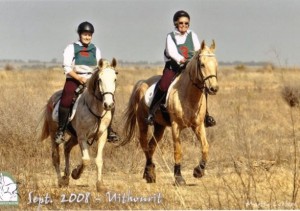Published in the SA Horseman, September 2009
How important is your riding position in Endurance riding?
Stability and position are important in riding but in Endurance riding, with the amount of time and distance travelled on horseback, this can become a vital issue.
A new study of riding stability and the forces exerted on a horse’s back by different riding positions at the trot may cause some Endurance riders to reconsider the way they ride. The study, conducted by the University of Veterinary Medicine in Vienna Austria, looked at side-to-side movement, forward-backward movement and the load on the horses back in sitting trot, rising trot and the two-point position.
The study found that, not only did the rider have greater stability in the two-point position but also created less load on the horse’s back. The next best position was rising trot and then sitting trot. The findings are probably not unexpected and similar findings at different gaits could reasonably be expected. The question is really then what this means for Endurance horses and riders?
Most Endurance riders will sit deep into the saddle, often in an armchair-like position. This is partially due to the design of the saddles most commonly used in Endurance riding but is also a common riding fault. Riders will dismount at regular intervals, possibly walking or running beside their horse for short distances to give the horse a break from the rider’s weight in the saddle whilst still moving forward.
Of course, standing in the stirrups for 60 or 160km would tire the rider very quickly. Rising trot for long distances is just as tiring. Although, by using the two-point seat during the ride, you reduce the load on the horse’s back by up to 25%, the resultant strain on the rider can also be detrimental. Then again, the rider’s soundness has no bearing on vetting scoresJ!
The next question is then how common back injuries are in Endurance riding. Although the most common muscoloskeletal injury to endurance horses is suspensory ligament strain (the ligament from the knee or hock to the fetlock); back injuries and injuries related to tack (eg. Saddle sores) are also common, partly due to the time that tack and rider spend on the horse. Thus, it seems that precautions to limit such injuries would be sensible.
Correctly fitting tack is still one of the biggest concerns and many riders still believe that extra padding is the answer when in fact, the padding may not only create undue heat but can also narrow the gullet of the saddle (especially English tree-type saddles) and actually cause more pressure. Too much padding can also make the saddle less stable on the horse’s back and will move more as a result. The amount of force exerted on the horse’s wither when mounting from the ground is also significantly higher than if using a mounting block or rock to mount from and, if the saddle is poorly fitted, can move during the mounting.
What about stability? If you have every carried a child piggy-back or had a rider behind you on a motorbike, you will know how easily off-balanced you are by the child or passenger who moves in the wrong direction at the wrong moment. Now consider the Endurance horse, cantering or galloping over uneven ground with your weight on his back. Naturally, instability of the rider can be detrimental to the horse, tiring him out quicker and possibly increasing the load on his back or causing him to trip or become unbalanced. A more stable riding position would thus be beneficial to the horse and ensure that the rider stays on board most of the time.
In fact, most suspensory ligament injuries occur during the weight-bearing phase of the stride due to uneven ground or poor foot balance. Thus, a more stable rider could assist a horse in maintaining better balance over uneven ground and could reduce the possibility of such injuries. Other contributors to such injuries are insufficient warm-up and deep sand/mud.
So, what is the conclusion? Each position does have its place and it is possible to alternate between these positions during a ride. The two-point position is best when the horse needs to gallop freely and the rider needs minimum control but it can put the horse on the forehand and thus less balanced around tight corners. A full-seat is best for tight turns and where more control of the horse is required. A half-seat is somewhere between the two.
Being conscious of how much our riding and position affects our horses will ensure that we are more likely to finish the course and go the distance when entering a ride.


